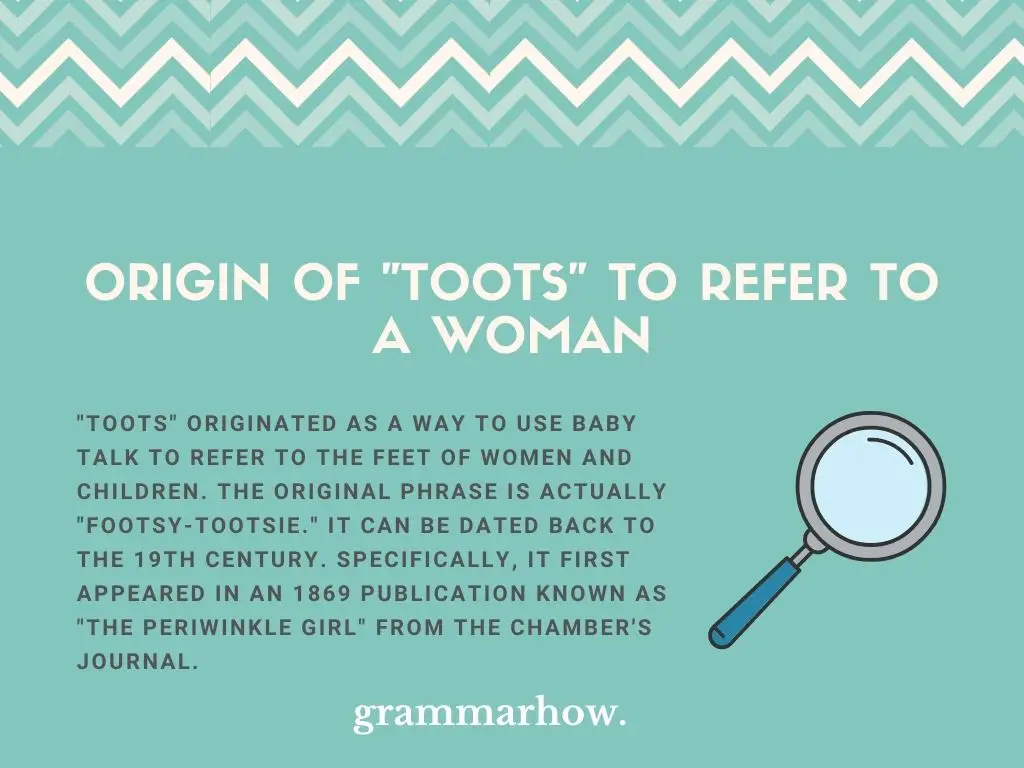The more you search for them, the more slang words you’ll find. The beauty of slang in most languages is that there seems to be a word for everything. This article will look into using “toots” to refer to a woman (and where it came from).
Origin of “Toots” to Refer to a Woman
“Toots” originated as a way to use baby talk to refer to the feet of women and children. The original phrase is actually “footsy-tootsie.” It can be dated back to the 19th century. Specifically, it first appeared in an 1869 publication known as “The Periwinkle Girl” from the Chamber’s Journal.

The term “footsy-tootsie” dates back even earlier than that. It seems to have been established in the 19th century, but it wasn’t until “The Periwinkle Girl” that it evolved to speak about woman’s feet.
A Guilt Chain, Truth, 1880
In 1880, “tootsie” was now the common phrase used to refer to women’s and children’s feet. There was a story called “A Guilt Chain,” which was the first of its kind to use “tootsie” as a colloquial term of endearment.
After this publication, “tootsie” started to be treated as a pet name for women. It was beginning to lose the foot meaning entirely.
Wynema: A Child of the Forest, 1891
This novel, published by Sophia Alice Callahan, was the first to use “toots” as a slang term to refer to a familiar woman. It was used to refer to one of the characters in the novel. “Tootsie” was no longer used, and “toots” became the shortened form.
Since this novel in 1891, “toots” became a very popular term to refer to women. It was mainly used by men, similar to words like “babe” or “honey” that you might hear today.
It’s no longer as popular as it was in the late 19th and early 20th-century, but it still circulates enough to be worth knowing.
What Does Calling a Woman “Toots” Mean?
“Toots” is a familiar term of address directed at a woman. It’s similar to using pet names like “baby,” “honey,” or “sugar.” It’s mainly used by men as a way to speak to women they are familiar with. You should not use it if you don’t know the woman, though.
Like so many pet names today, “toots” is offensive if you don’t know your audience. You should not randomly decide to call your boss or a random woman on the street “toots.” They will not enjoy the name. It will make you seem misogynistic rather than friendly.
If you want to know how to use “toots” in a sentence correctly, you can refer to the following:
- Hey, toots! How are you doing today? I feel like I haven’t seen you in forever.
- That’s toots over there! I should probably go over and say hi before she yells at me for ignoring her.
- Sorry, toots. If I had known that I’d be so busy at work, I would have definitely called you sooner to let you know.
- Look, toots, I’m afraid we have to work these things out before we can move forward.
- My toots should be arriving shortly. I really hope you all make her feel welcome! She’s really nice.
- Hey, toots! You’re looking good today. I hope I’ll get to see you again later after the movie!
- He calls me toots all the time. I didn’t like it at first, but it’s really grown on me.
Toots or Tootsie?
“Toots” came from “tootsie.” The two words can be somewhat synonymous, but “tootsie” is much more common when referring to someone’s feet (it doesn’t strictly refer to women’s feet in today’s language).
You’ll often find that “tootsie” is used to cutely refer to someone’s feet. If you call someone “tootsie,” they might be a bit confused about why you’re referring to them as a foot.
- Look at all your little tootsies! They look so cold! Maybe you should put a sock on.
- Her tootsies are really cute. I like looking at them.
As you can see, “tootsies” is still best used when you’re referring to the feet of someone you care for. It’s weird to use a term like this when you’re talking about a stranger’s feet.
Final Thoughts
“Toots” is a pet name for a woman. It originated as a term to refer to women’s feet, but it shifted away from that and became its own word. It’s not particularly common today, and many women think it’s sexist if you don’t know them well enough to use it.

Martin holds a Master’s degree in Finance and International Business. He has six years of experience in professional communication with clients, executives, and colleagues. Furthermore, he has teaching experience from Aarhus University. Martin has been featured as an expert in communication and teaching on Forbes and Shopify. Read more about Martin here.
